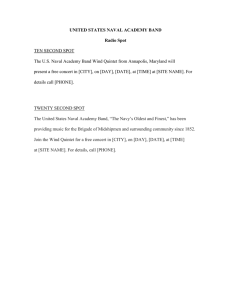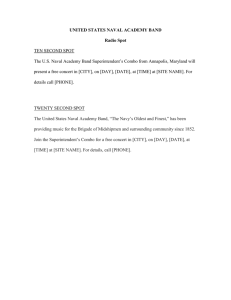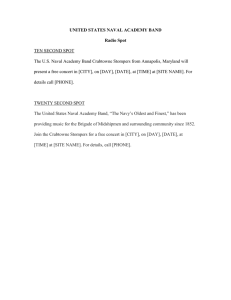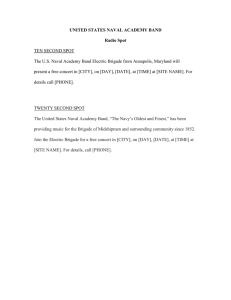ISSAC’04 Tutorial
advertisement
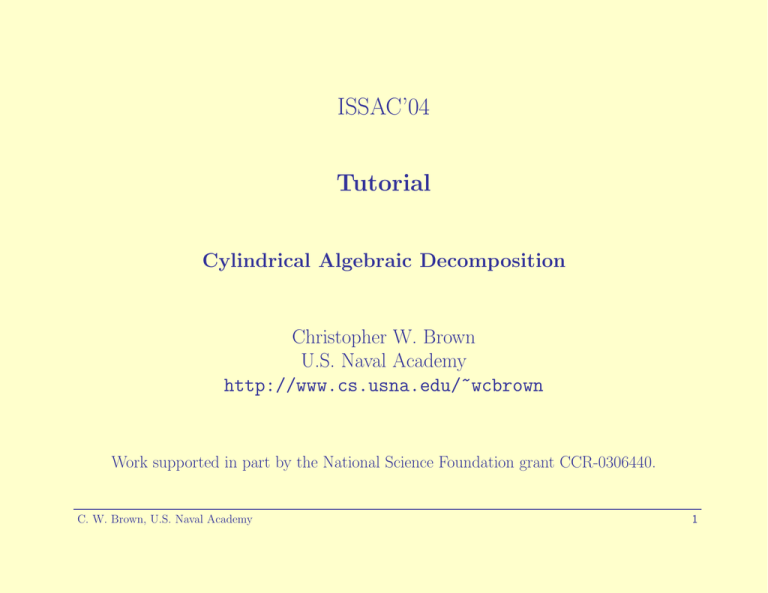
ISSAC’04
Tutorial
Cylindrical Algebraic Decomposition
Christopher W. Brown
U.S. Naval Academy
http://www.cs.usna.edu/~wcbrown
Work supported in part by the National Science Foundation grant CCR-0306440.
C. W. Brown, U.S. Naval Academy
1
Preface
Goal: To compute symbolically with semi-algebraic sets in practice.
Definition: The semi-algebraic sets in Rn are defined recursively by:
1. the set of points satisfying p σ 0, where p ∈ R[x1, . . . , xn] and
σ ∈ {=, 6=, <, ≤, >, ≥}, is semi-algebraic
2. the complement of a semi-algebraic set, and the union or intersection of
finitely many semi-algebraic sets are semi-algebraic.
C. W. Brown, U.S. Naval Academy
2
Preface
Semi-algebraic sets are usually represented by Tarski Formulas.
Definition: A Tarski Formula is boolean combination of polynomial equalities and inequalities.
Tarski formulas map directly to the definition of semi-algebraic sets:
x1 6= 0 ∧ x22 − 4x1x3 > 0
−→
x1 6= 0 ∩ x22 − 4x1x3 > 0
x21 + x22 − 1 ≤ 0 =⇒ x1 + x2 ≥ 0
−→
x21 + x22 − 1 ≤ 0 ∪ x1 + x2 ≥ 0
So we may view semi-algebraic sets from the standpoint of geometry or of logic.
One viewpoint: the objects are geometric, the representations are logical.
C. W. Brown, U.S. Naval Academy
3
Introduction
What is “Cylindrical Algebraic Decomposition”?
Cylindrical Algebraic Decomposition (CAD) provides an explicit representation for semi-algebraic sets, in which many operations and queries can be
carried out easily.
C. W. Brown, U.S. Naval Academy
4
Tutorial Outline
• Motivate
• Develop intuition
• Present CAD fundamentals more rigorously
• Present what you need to use and adapt CAD effectively
• Analyze some case studies
C. W. Brown, U.S. Naval Academy
5
Problems
1. An application from epidemiology
2. Triangles and Euclidean geometry
3. The role of Rolle’s theorem
C. W. Brown, U.S. Naval Academy
6
An Epidemiological Problem
• Andreas Weber and colleagues have applied symbolic tools to epidemiological
models.
• We consider the SEIT model, used to model tuberculosis in van den Dreissche & Watmough, 2002.
• Uses system of ODEs to model movement of disease through population.
Model contains many parameters.
• Question: For what parameters is there an endemic equalibirum, i.e. an
equilibrium that doesn’t have the disease dying out.
C. W. Brown, U.S. Naval Academy
7
An Epidemiological Model
S 0 = d − dS − β1IS
E 0 = β1IS + β2IT − (d + ν + r1)E + (1 − q)r2I
I 0 = νE − (d + r2)I
T 0 = −dT + r1E + qr2I − β2T I
S susceptibles
E exposed (not yet infectious)
I infectious
T under treatment
C. W. Brown, U.S. Naval Academy
β1, β2 transmission parameters for S and T
d birth and death rate (assumed equal)
ν rate of change from exposed to infectious
r1, r2 treatment rates for E and I
q fraction of infectious successfully treated
8
Endemic equilibrium
• an endemic equilibrium satisfies 0 = S 0, E 0, I 0, T 0 and 0 < S, E, I, T
• for what parameter values is there a solution satisfying 0 < S, E, I, T for:
0 = d − dS − β1IS
0 = β1IS + β2IT − (d + ν + r1)E + (1 − q)r2I
0 = νE − (d + r2)I
0 = −dT + r1E + qr2I − β2T I
assuming all parameters positive?
C. W. Brown, U.S. Naval Academy
9
Endemic equilibrium problem
• It’s easy to solve for E,I and T in terms of S three of the equations. Substituting the results into the fourth gives P = 0, where
P = − νS 2β12 + β1νS 2β2 + dβ1Sr2 − d2β2S + d2β1S + β1Sr1r2 − dνSβ2
+ νβ1Sqr2 − dβ2r2S + dνSβ1 − β1Sνβ2 + β1Sr1d + β2d2 + νβ2d + β2dr2
• The condition 0 < S, E, I, T is easily seen to be equivalent to 0 < S < 1.
• So there is an endemic equilibrium for any assignment of positive parameter
values for which there is a a real value S such that P (S) = 0 ∧ 0 < S < 1,
i.e.
∃S [P (S) = 0 ∧ 0 < S < 1]
C. W. Brown, U.S. Naval Academy
10
External Trisector
A
Given triangle ABC, consider the
“external trisector of B with respect to A” as defined in the figure.
c
Clearly, the trisectors exist if and
only if (π − φ)/3 < θ.
Problem: Characterize the existence of the external trisector of B
with respect to A in terms of the
side lengths a, b, c.
C. W. Brown, U.S. Naval Academy
B f
b
a
q C
(p-f)/3
11
Converting from angles to side lengths
Using standard trig identities we see that (π − φ)/3 < θ is equivalent to
cos θ ≤ cos
π
π
∨ cos θ > cos ∧ cos φ < −4 cos3 θ + 3 cos θ
3
3
Using the law of cosines to describe cos θ and cos φ in terms of the side lengths
a, b and c, and clearing denominators, we get
2
2
2
2
2
2
2
2
a +b −c < ab∨a +b −c ≥ ab∧−c a + b − c
C. W. Brown, U.S. Naval Academy
2 3
2 2
2
2
+3a b c a + b − c
2
12
The External Trisector Problem
In the triangle with side lengths a, b, c, the external trisector of B w.r.t. A
exists if and only if:
2
2
2
2
2
2
2
2
a +b −c < ab∨a +b −c ≥ ab∧−c a + b − c
2 3
2 2
2
2
+3a b c a + b − c
2
Problem: Is there a simpler characterization?
C. W. Brown, U.S. Naval Academy
13
Rolle’s Theorem
• Background: from Bruce Anderson’s PhD thesis, with Moss Sweedler, Cornell, 1992.
• Rolle’s theorem: between any two zeros of f (x) there is a zero of f 0(x).
• Generically: from x = −∞ to x = +∞ the signs of f and f 0 can be
f + −−+
f 0 −−+ + . . .
, but cannot be
C. W. Brown, U.S. Naval Academy
f + −+
f 0 −−− . . .
according to Rolle’s theorem.
14
Sequence of “Sign-Stacks”
−
+
−
+
+
+
−
+
C. W. Brown, U.S. Naval Academy
+
−
−
+
+
−
+
+
+
+
+
+
f(x)
f’(x)
f’’(x)
f’’’(x)
15
Sign-stack sequence restrictions
Consider the sign-stack sequence of a generic, monic, univariate polynomial.
1. monic implies: the bottom entry is always +, the first sign-stack is alternating +’s and −’s, and the last sign-stack is all +’s
2. generic implies: consecutive sign-stacks differ in only one entry
3. Rolle’s theorem implies: from one sign-sequence to the next, an entry may
only be changed to equal the entry below it
A sequence satisfying these requirements is called legal.
C. W. Brown, U.S. Naval Academy
16
“Rolle’s Theorem Problem”
Problem: is every legal sign-stack sequence realizable by a polynomial?
There are lots of legal sign-stack sequences!
degree of f
# legal sequences
C. W. Brown, U.S. Naval Academy
1
1
2
2
3
6
4
42
5
1000
6
114650
7
77740200
17
Questions?
C. W. Brown, U.S. Naval Academy
18
